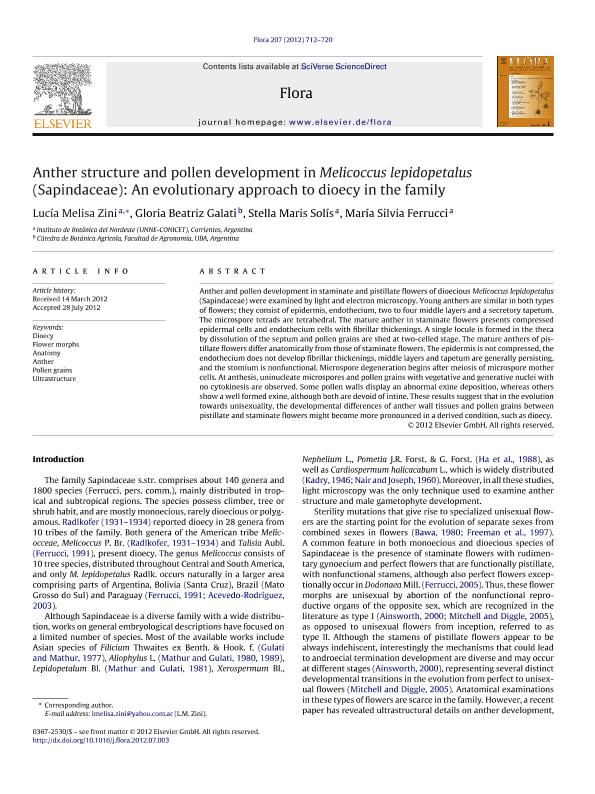Mostrar el registro sencillo del ítem
dc.contributor.author
Zini, Lucia Melisa

dc.contributor.author
Galati, Beatriz Gloria

dc.contributor.author
Solis, Stella Maris

dc.contributor.author
Ferrucci, María Silvia

dc.date.available
2017-08-04T19:15:31Z
dc.date.issued
2012-10
dc.identifier.citation
Zini, Lucia Melisa; Galati, Beatriz Gloria; Solis, Stella Maris; Ferrucci, María Silvia; Anther structure and pollen development in Melicoccus lepidopetalus (Sapindaceae): an evolutionary approach to dioecy in the family; Elsevier Gmbh; Flora; 207; 10-2012; 712-720
dc.identifier.issn
0367-2530
dc.identifier.uri
http://hdl.handle.net/11336/21882
dc.description.abstract
Anther and pollen development in staminate and pistillate flowers of dioecious Melicoccus lepidopetalus (Sapindaceae) were examined by light and electron microscopy. Young anthers are similar in both types of flowers; they consist of epidermis, endothecium, two to four middle layers and a secretory tapetum. The microspore tetrads are tetrahedral. The mature anther in staminate flowers presents compressed epidermal cells and endothecium cells with fibrillar thickenings. A single locule is formed in the theca by dissolution of the septum and pollen grains are shed at two-celled stage. The mature anthers of pistillate flowers differ anatomically from those of staminate flowers. The epidermis is not compressed, the endothecium does not develop fibrillar thickenings, middle layers and tapetum are generally persisting, and the stomium is nonfunctional. Microspore degeneration begins after meiosis of microspore mother cells. At anthesis, uninucleate microspores and pollen grains with vegetative and generative nuclei with no cytokinesis are observed. Some pollen walls display an abnormal exine deposition, whereas others show a well formed exine, although both are devoid of intine. These results suggest that in the evolution towards unisexuality, the developmental differences of anther wall tissues and pollen grains between pistillate and staminate flowers might become more pronounced in a derived condition, such as dioecy.
dc.format
application/pdf
dc.language.iso
eng
dc.publisher
Elsevier Gmbh

dc.rights
info:eu-repo/semantics/openAccess
dc.rights.uri
https://creativecommons.org/licenses/by-nc-sa/2.5/ar/
dc.subject
Dioecy
dc.subject
Flower Morphs
dc.subject
Anatomy
dc.subject
Anther-Pollen Grains-Ultrastructure
dc.subject.classification
Bioquímica y Biología Molecular

dc.subject.classification
Ciencias Biológicas

dc.subject.classification
CIENCIAS NATURALES Y EXACTAS

dc.title
Anther structure and pollen development in Melicoccus lepidopetalus (Sapindaceae): an evolutionary approach to dioecy in the family
dc.type
info:eu-repo/semantics/article
dc.type
info:ar-repo/semantics/artículo
dc.type
info:eu-repo/semantics/publishedVersion
dc.date.updated
2017-07-17T13:49:17Z
dc.journal.volume
207
dc.journal.pagination
712-720
dc.journal.pais
Alemania

dc.journal.ciudad
Berlín
dc.description.fil
Fil: Zini, Lucia Melisa. Consejo Nacional de Investigaciones Científicas y Técnicas. Centro Científico Tecnológico Conicet - Nordeste. Instituto de Botánica del Nordeste. Universidad Nacional del Nordeste. Facultad de Ciencias Agrarias. Instituto de Botánica del Nordeste; Argentina
dc.description.fil
Fil: Galati, Beatriz Gloria. Universidad de Buenos Aires. Facultad de Agronomia; Argentina
dc.description.fil
Fil: Solis, Stella Maris. Universidad Nacional del Nordeste. Facultad de Ciencias Agrarias; Argentina
dc.description.fil
Fil: Ferrucci, MarÍa Silvia. Consejo Nacional de Investigaciones Científicas y Técnicas. Centro Científico Tecnológico Conicet - Nordeste. Instituto de Botánica del Nordeste. Universidad Nacional del Nordeste. Facultad de Ciencias Agrarias. Instituto de Botánica del Nordeste; Argentina
dc.journal.title
Flora

dc.relation.alternativeid
info:eu-repo/semantics/altIdentifier/doi/http://dx.doi.org/10.1016/j.flora.2012.07.003
dc.relation.alternativeid
info:eu-repo/semantics/altIdentifier/url/http://www.sciencedirect.com/science/article/pii/S0367253012001272
Archivos asociados
